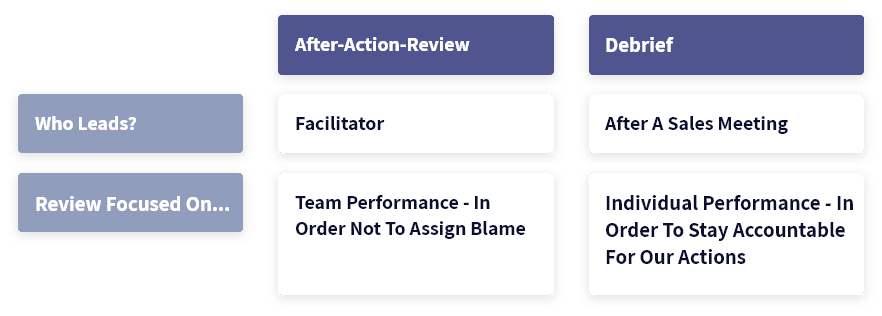How do these two popular continuous improvement tools stack up, and which should you choose to help you build a high-performance organization.
Building a continuous improvement culture is critical when you find your organization at a juncture, growing rapidly but seeking to maintain the transparent and open culture that got you to that point. Among many continuous improvement tools at your disposal to build that culture, two in particular help take stock of an event, milestone, or project after the fact, reflect on what happened and use that reflection to move forward: the debrief, and the after-action review, or AAR.
Given the many similarities between these tools, it can be easy to confuse between them, when in fact they are not quite the same. Read on to understand how each tool is structured, and which may better serve your growing organization’s learning needs.
Debriefing by Shamaym: Structure and Benefits
Debriefing is a quick and powerful method for dissecting the successes and errors in your work and identifying ways to change processes in the future. When we founded Shamaym we refined our debrief structure from its origins in the Israeli Air Force, into three simple questions asked in the presence of all individuals involved in the event being debriefed:
- What happened?
- Why did it happen?
- How can I improve the outcome in the future?
Debrief sessions routinized into existing workflows can shift the mindset of individuals and teams, catalyze culture change, and even lead to growth in an organization’s bottom line. Just some of the benefits of debriefing include:
- Improves individual, team, and organizational performance – plain and proven.
- Sparks creative ideas for improvement that may have otherwise remained unspoken.
- Contributes to the development of a deep-rooted organizational culture and DNA.
- Provides a framework for quickly changing course in an uncertain business environment.
- Encourages a safe environment where individuals take responsibility for their actions, and simultaneously…
- Builds resilience – team members learn to endure the discomfort of publicly admitting fault.
After-Action-Review: Structure and Benefits
An After-Action-Review, or AAR, is an organizational learning tool in which a team comes together to reflect on and discuss an event, milestone, or project. Similarly to a debrief, an After-Action-Review is conducted in close proximity to the completion of the event, include the participation of all individuals involved in that event, and ask four questions:
- What was expected to happen?
- What actually happened?
- What went well and why?
- What can be improved and how?
The benefits of AAR also bear many similarities to a debrief. AAR provides the opportunity to examine events right after they happen, while memory is fresh, and to immediately deduce lessons. It creates an opportunity for open dialogue and learning even in an overwhelmed organization.
Key Differences Between AAR and Debriefing by Shamaym
The similarities between debriefing and AAR are clear. But the devil (and, in this case, the differences), is in the details.

AAR uses a facilitator as a neutral party to lead the discussion. The facilitator keeps the discussion non-judgemental. But the facilitator is also elevated to a different role, and doing so may bring political and power considerations into the room, potentially steering the AAR discussion away from what matters most to other participants.
A debrief, in contrast, is more democratic in nature. It keeps all individuals involved on equal footing and centers the discussion around objective observations and operative suggestions for improvement.
AAR focuses on team, not individual performance, as a means of not assigning blame. A debrief actually focuses on individual performance in that its structure encourages each individual to speak only to factors within their control. A debrief isn’t about assigning blame. But it is about taking personal responsibility for the pieces of the debriefed event within a team member’s control. That is important because once a team member publically takes responsibility for an action, that team member can also take ownership over improving future outcomes.
Final Thoughts – AAR or Debriefing: Which Tool Should my Organization Use?
Debriefing and After-Action-Review are both great tools for reflection and processing of a significant event. Both help to ensure that lessons from past performance are carried into future work. But debriefing offers advantages to companies concerned about maintaining or improving their culture when they are on the precipice of significant growth.
In its focus on narrowing in on what matters most, and on what is within our control to improve, debriefing is uniquely suited to a rapidly changing business environment, and to the needs of a growing organization, where today’s priorities might not be the same tomorrow. That environment is quickly becoming the norm, so we invite you to learn how to use debriefing to implement a continuous improvement culture in your organization right now.
